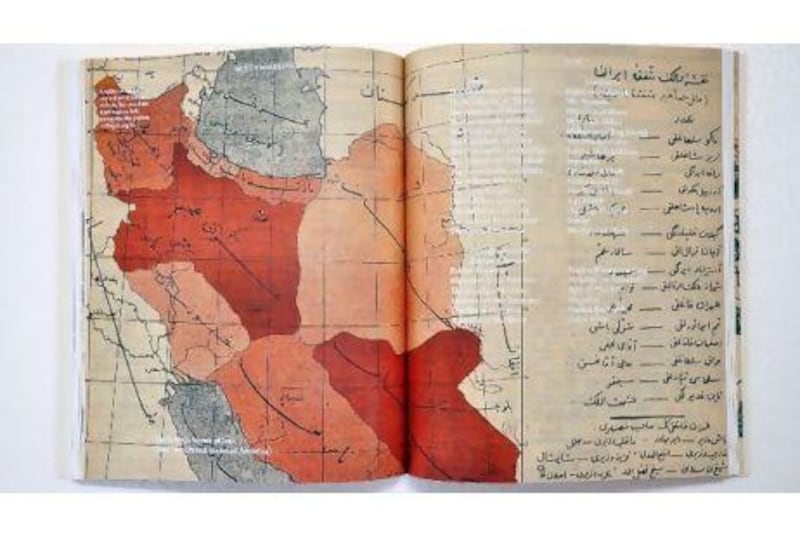The backstreets of Baku, the capital of Azerbaijan, have a certain, winding magic. They house former caravanserai, once flophouses offered to travellers throughout central Asia, that have today been polished up into candlelit restaurants. Tall, grey blocks mingle with flourishes of Persian architecture - a symbol of Baku's straddling geography between Russia and Iran.
But there are dozens of bookshops tucked away in these streets, shelves stacked with first editions and Soviet periodicals from the city's communist era, which ended in 1991.
It was in one of these booksellers near Maiden Tower that Slavs and Tatars, a collective of artists and writers, discovered a true bibliophile's dream: editions of one of the region's most daring yet overlooked satirical publications, Molla Nasreddin.
Stating their sphere of interest as everything east of the former Berlin Wall and west of the Great Wall of China, Slavs and Tatars make this loosely defined area of Eurasia their patch. Starting as a reading group that shared translations of books from this region (what they call "an arcane version of the Oprah Winfrey book club"), they've since exhibited sculptures and installation work in museums internationally, and been part of group shows at The Third Line gallery in Dubai.
"The illustrations drew us to Molla Nasreddin," says Slavs and Tatars. "They're reminiscent of Honore Daumier or Toulouse Lautrec."
Molla Nasreddin was founded in 1906 by editor-in-chief Jalil Mammadguluzadeh and satirist-poet Mirza Sabir, both proud Azeris yet champions of a "modern" and markedly western system of values. It espoused this worldview via beautifully wrought yet withering cartoons and editorials that remain biting today.
Few were spared the editorial wrath: suffocating and outmoded fanatics, meddling European and Russian imperial powers, the position of women in society at that time and the hypocritical elite. Education, equality and regional independence, through a lens of secularism, was Mammadguluzadeh and Sabir's vision for central Asia's future.
It was penned in Azeri Turkish in three different scripts - Arabic, Cyrillic and Latin alphabets - showing the three forms that the language went through as Azerbaijan passed into Soviet hands. This made translation into English difficult when Slavs and Tatars set out to publish a reader in 2011, titled Molla Nasreddin: The Magazine That Would've, Could've, Should've, now available at The Third Line.
The book features their selections from 3,000 illustrations, curated into the different avenues of critique that the magazine took - such as Education, Colonialism and Women.
One illustration, for instance, shows two Azeri women wrapped from head to toe in fabric, and pointing in envy at the barred windows of a prison. The caption alongside reads: "Sister, look how lucky they are: they have windows!"
In another, five beaten-down Azeri men carry bespectacled donkeys on their back; plumes of smoke rise from long cigarette holders in the mouths of these remarkably aristocratic looking beasts.
Despite moving offices to and from Georgia and Iran, intermittent bans, and 10 years of the Soviets increasingly shoving editorial directives down the throats of the magazine's staff, Molla Nasreddin survived until 1931. Simultaneously, a cloud of obscurity seemed to settle over a region that, says Slavs and Tatars, had been one of the most intellectually and politically important places in the past 2,000 years.
"If anybody even takes notice of this region, they think of it as obscure, especially the more west you go - you talk to people about Kyrgyzstan, and you might as well be talking about Star Wars," says Slavs and Tatars. "But Baku was producing half of the world's oil until the first half of the 20th century," noting as well that Azerbaijan was one of the first countries in which women could vote (well before the UK), and publications such as Molla Nasreddin demonstrate an intellectual, progressive rigour from this part of the world that has been so far overlooked.
"That's why we're called Slavs and Tatars and not by our real names: it's not the work of a group of artists but the work of a region that has many nationalities, and had a shared heritage at some point.
"From the point of view of the West, with this nonsense that passes as conventional wisdom that the West and Islam are on a collision course; you have to look at a part of the world where they have long coexisted." Namely, Eurasia.
The collective say, however, that Molla Nasreddin is also their antithesis in that it took modernity to mean westernisation. "We don't believe that at all, in fact we believe in quite the opposite - more of an indigenous or hybridised form of modernity. "
But they still acknowledge its historical significance: "It's a shame that it came down to us as artists and writers in the early 21st century to rediscover one of the most important publications of the Muslim world," they continue. "That's testament to how overlooked this part of the world is.
"Very few people would spend two years of their life working on something they disagree with, but we are living in an increasingly insular world intellectually - less and less are we embracing the things that we disagree with."
Slavs and Tatars presents Molla Nasreddin: The Magazine That Would've, Could've, Should've is available at The Third Line gallery in Dubai, priced Dh250. The collective will have an exhibition at the gallery in early-to-mid 2012






